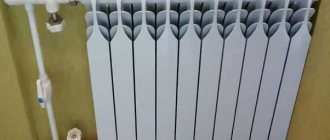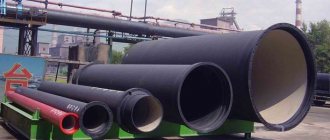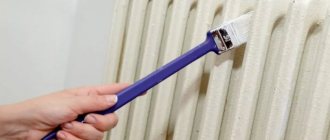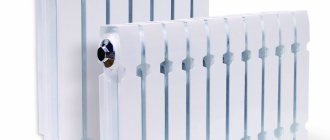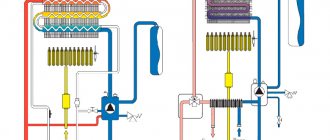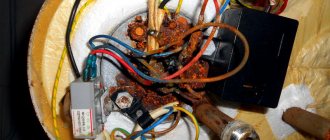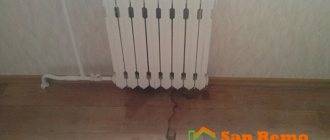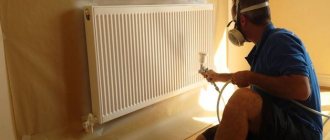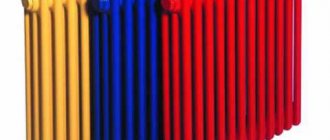Cast iron radiators have been the most popular for half a century. Nowadays they are also very popular, but, nevertheless, their popularity among competitors is growing every year:
- bimetallic;
- aluminum;
- steel radiators.
It is worth noting that during the Soviet Union, such “retro” radiators were used everywhere, and there was no particular alternative to them. Please note that all buildings of that era have cast iron heating radiators.
Cast iron radiators
The batteries used during the Soviet Union are model ms 140. They received this name due to their power of one section, it is equal to 140 watts. Such batteries have good technical characteristics even today.
Modern models of cast iron radiators (such as the Konner brand) are similar in quality, design and construction to aluminum and bimetallic heating devices.
Cast iron batteries are designed for a pressure of eight atmospheres. It is best to place them under windows. This arrangement improves convection heat transfer.
Advice! To improve the heat transfer of your cast iron batteries, wash them every two to three years. In this way you will clean it of rust and other debris.
Advantages
- These radiators have proven their reliability over time;
- The service life of cast iron radiators is at least fifty years, due to their high corrosion resistance;
- Due to the fact that radiators have thick walls and a large internal volume of water, they can concentrate a lot of heat;
- The price of cast iron radiators is low, but despite this, they are resistant to aggressive elements and contaminants in the water;
- Cast iron does not have the ability to flow, compared to steel;
- They function normally when working with poor coolant. That is why they have become so widespread;
- Possibility of installing cast iron batteries with your own hands.
Flaws
- During long-term use, rust accumulates in radiators;
- Cast iron batteries have a small heat transfer surface and low thermal conductivity of the metal. The room is heated by radiation, and only twenty percent of the heat is released to the air by convection. Thus, taking into account the heating area, normal heating of a room will require the installation of a dozen sections;
- In an apartment building there will be tons of water and cast iron batteries. This will require the installation of large piping. Such pipes cannot be hidden in the walls of the building, and the large weight of cast iron batteries can cause difficulties during their installation;
- Given the large volume of water in the system, cast iron heating radiators require more time to heat the room. Knowing the great inertia of radiators, it becomes obvious that it is impossible to implement an adjustment mechanism on each radiator;
- Poor integration of cast iron radiators into existing systems that are equipped with automation. As a consequence, there is no possibility of saving fuel;
- Heat from the heat source enters the cast iron heating device slowly. Let's give an example: in order to heat one ton of water to sixty degrees Celsius, it is necessary to provide a supply of water that has a temperature of at least seventy-five degrees. As a result, water with a temperature of forty-five degrees will flow in the opposite direction.
In order to heat a ton of water to a temperature of seventy-five degrees, you will need a powerful boiler. At least ten degrees will be lost in massive metal pipes, which will entail the need for the boiler to work at the maximum of its capabilities, producing ninety degrees. It is unrealistic and impossible to achieve a temperature such that a cast-iron radiator reaches ninety degrees.
Calculation of the number of sections
Technical calculations of radiators can be performed using different techniques. There are precise algorithms that take into account many parameters of the material, configuration and location of the room. We will present a simplified formula that allows us to estimate the desired value with sufficient accuracy, and then we will show how to modify the result if the conditions differ from the standard ones.
So, the number of sections can be determined if the area of the room is multiplied by 100 and divided by the power of the section in Watts.
Now some tips:
- If you get a fractional number, increase it upward - a heat reserve is better than insufficient heating of the room;
- If there are two windows in the room, it is preferable to install two batteries, distributing the resulting number of sections among them. This will increase the service life and maintainability of the heating system. In addition, radiators will create an effective barrier to cold air from the windows;
- If the room has two external walls or the ceiling height is more than 3 m, it is better to add one or two sections to compensate for heat loss. The same can be done if there is an unheated attic upstairs.
Connection options for cast iron batteries
Cast iron heating batteries can be connected in the following ways:
- Diagonal connection. This installation option is used to connect multi-section heating devices. The supply pipeline is connected to the upper fitting on one side of the radiator, and the return pipe is connected to the lower fitting on the opposite side.
If heating devices are connected in series, the coolant will move under the pressure of the heating system. To remove air from the system, Mayevsky taps are installed. The disadvantage of this system is revealed when it is necessary to repair the heating element, since installing batteries in this way does not imply the possibility of removing the batteries without turning off the system;
- Bottom connection. This type of connection is used when the pipes are located in the floor of the room or under the baseboard. This type of connection is the most ideal in terms of beauty. The return and supply pipes are located at the bottom and are directed vertically to the floor;
- Lateral one-way connection. It is the most common type of connection; if you wish, you can find many photos and videos about it on the Internet. The essence of this connection is to connect the supply pipe to the upper fitting, and the return pipe to the lower one. It should be noted that this connection gives the greatest heat transfer. If you connect the pipelines in reverse, the power drops by approximately ten percent. The installation instructions say that in case of poor heating in radiators with a large number of sections, you need to install a water flow extension.
- Parallel connection. In this case, it is done through a pipeline that is connected to the supply riser. Hot water leaves through a pipeline that is connected to the return line.
Dimensions and weight
The dimensions, weight and appearance of cast iron radiators are a sore point for all owners and installers of such devices. Let's see if everything is so terrible, using the example of the most popular domestic radiator - MS-140.
- Radiator height – 59 cm;
- Section depth – 14 cm;
- Section width – 9.3 cm;
- Weight – 7 kg;
- Section capacity – 1.4 l;
- Section power – 160 W.
Of course, moving and installing 10-section radiators weighing 70 kg is not the greatest pleasure, but this is done only once (the technicians and installers are probably smiling sadly now).
But in terms of the amount of coolant, the cast iron battery is really not impressive - 14 liters for these 10 sections need to be heated and delivered.
In a city apartment this is not a big burden, but if thermal energy is taken from the boiler of an autonomous heating system, then the extra cubic meters of gas or kilowatts of electricity will have to be paid out of your own pocket.
Types of radiators
If cast iron batteries began to be used in Russia in 1857, then such innovations as steel, aluminum and bimetallic heating structures appeared relatively recently.
Each of them has its own advantages and disadvantages, as well as its own period for replacing heating batteries in an apartment:
- for aluminum systems it is 20-25 years;
- bimetallic radiators will last up to 30;
- steel - the most short-lived, only 15-20 years;
- Modern cast iron batteries will provide warmth for up to 35 years.
The service life of heating batteries in an apartment stated in the technical data sheet does not always coincide with reality, since in this case the way they are used plays a huge role.
To decide which type of radiator to use, you need to pay attention to the following parameters:
- What is the working pressure in the heating system of the house, and what is indicated in the data sheet, and how compatible they are.
- You should find out the Ph and purity of the coolant and correlate it with the heating system.
- The heating temperature must also be the same.
Each of the parameters needs to be checked for compatibility with the selected type, and only after that decide whether to repair the heating in the apartment, and which radiators to use for this.
The operating pressure for high-rise buildings is from 8 to 16 atmospheres, while the selected heating system should have it at 2 atmospheres. higher. You can find out about the condition of the coolant from the company that supplies heat to the house.
If you focus when choosing radiators solely on their strength, then you need to take into account that cast iron is a rather fragile metal, the steel system at the junctions of the elements begins to quickly corrode, and aluminum is destroyed due to the increased acidity of the coolant.
Review of modern radiator models
Russian manufacturers are actively producing batteries; they also continue to produce them in the CIS countries (Belarus and Ukraine), in the USA, Czech Republic, Italy, Germany, Turkey, England and others.
The most popular manufacturers of modern cast iron batteries:
- TomBat
- GUARTEC
- Conner
"TomBat" with improved characteristics.
The German company GUARTEC produces high-quality batteries, distinguished by their original design and extended service life. With German pedantry, they approached the creation of batteries, popular in the 19th century, produced in France, England, and Germany. These radiators, made in Retro style, meet all modern technical requirements and serve as decoration for indoor spaces. They are made in different colors, bronze, copper, and cast iron.
Konner radiators manufactured in China are manufactured according to the designs of experienced engineers; these products are fully adapted to domestic realities. The radiators have a modern design; the manufacturing process already at its first stage controls compliance with all standards; each element is tested for strength and quality. The batteries can operate in conditions of natural and forced water circulation. Their heat output varies depending on the model, for example, in the C.R. Konner Modern 500, weighing 4.75 kg, the heat dissipation per section is 150 W, and in the C.R. Konner Modern 300 - 120 W, which weighs 3.5 kg. The price for one radiator element is the same - 500 rubles. They have different center distances and can be used in rooms with low and high window sills.
Durability of the heating system
As practice shows, the service life of cast iron heating radiators in an apartment, like aluminum and steel ones, strongly depends on the operating and test pressure in the system . For example, every new season, when it is launched, the batteries experience severe water hammer .
Only bimetallic batteries can withstand it for many years. For cast iron, aluminum and steel structures, this is a strength test every time, which affects their durability.
An important role is also played by the quality of accompanying elements , thanks to which structures can be disconnected, repaired or even changed.
These include:
- air release valves;
- ball valves to shut off the system.
They are needed when repairs of radiators (radiators) in an apartment are required or when a leak occurs.
Rapid removal of air from the system relieves the load on its elements, which has a positive effect on their durability.
Causes of failure
If the heating system has failed not because of its “antiquity”, then you should look for a fault somewhere else.
It could be:
- The radiator does not match the system of the apartment building. This may be due to pressure or quality of the coolant.
- Flaws when connecting to pipes , which can cause a breakthrough after a while.
- Operating conditions are not suitable for this type of radiator due to frequent pressure changes.
- If the coolant is too littered , then this causes the accumulation of suspensions at the attachment points, which in due time will lead to a leak.
- Gaskets between sections also do not last forever , and failure of one of them can compromise the integrity of the system.
Why don't they warm up?
It is extremely unpleasant at the height of the winter season to face the fact that either the whole or part of the heating system is cold. To figure out why the heating radiator in the apartment does not heat, the reasons need to be looked for in what is preventing the flow of coolant into the system.
There are only a few of them:
- This can be facilitated by airing of the heating system in an apartment building , which can be detected either tactilely by probing the batteries in search of a cold area, or by the sound of the coolant, which is forced to “press” through the disturbed area.
- If there is not enough water in the system , this will lead to an air lock in the entire structure due to the lack of proper circulation.
- When the heating installation is old , then its “weak link” is congestion in the pipes. Over many years of operation, suspensions and rust settling on the bottom clog their narrowest part. This can also be detected tactilely.
- If the batteries were connected incorrectly , then they will remain cold, and only the pipes will be hot.
You can eliminate some of the reasons yourself, for example, remove the air lock.
The heating battery in the apartment has burst - what to do:
- If there is a circulation pump, it must be turned off to relieve excess pressure on the system.
- Open the Mayevsky tap , and if there is none, then remove the plugs from the battery .
- These actions will cause air to escape from the system , which occurs with a characteristic hissing sound.
- After water flows from an open tap, turn it off.
It is necessary to prepare containers for the coolant in advance and wait until the whistling from the system stops completely. After some time, you can check the radiators for the presence of heat - if they are hot, then everything is done correctly.
If the reason that the radiators do not heat is a lack of coolant, then such work should not be carried out independently, without having the appropriate experience. When water enters the system, air pockets can form. If the system is clogged, it should also be entrusted to the experts, since this will require removing it for cleaning or completely replacing its damaged areas.
Repair of heating batteries in an apartment
The main question that arises when there are problems with heating in an apartment is where to go and who will pay for the repairs.
Since problems with radiators, especially outdated ones, happen frequently, so do legal “skirmishes” between residents and utility services. Representatives of the housing office each time claimed that they were in charge only of that part of the heating system that was located in the entrance, while the owners of the affected apartments proved the opposite.
This was the case until the law on communal property was adopted, according to which the entire heating system, even that located in private apartments, is under the jurisdiction of public utilities. The specialists of the organization that provides heat ensure that all radiators work efficiently , and the residents of the house contribute money monthly for major repairs of the heating system in an apartment building, if necessary.
The heating in the apartment is not working, who should I call? For any problems with the system, you need to call the appropriate service and its representatives will fix them free of charge.
This does not apply to cases where the heating is in order, and the residents decide to change the radiators to a newer model. In this case, the entire replacement occurs at the expense of the apartment owners.
When a heating radiator leaks in an apartment, this is caused by the following reasons:
- Their service life had long expired, and a breakthrough was only a matter of time.
- They could not withstand the pressure during the summer maintenance work. This may be due to the wrong choice of heating batteries.
To independently fix a broken heating battery in an apartment, which is usually not recommended, you can use epoxy resin-based glue, but only as a temporary solution to the problem until the emergency service arrives.
If the cause of the leak is a dried out gasket, then you can replace it yourself, provided that there is no water in the system. If the accident occurred during the heating season, then in order to avoid burns it is better not to do anything on your own.
As can be seen from the above, in order not to wait for extreme cases, you need to monitor the heating system, and if it does not heat, makes strange sounds or leaks, then you should call the housing office or emergency service.
If the radiators have long expired, there is no need to check them for durability, but replace them with a more modern model that matches the parameters.
Durability characteristics of heating radiators:
| Radiator type | Resistance to internal corrosion | Water hammer resistance | Average service life |
| Steel radiators | Weak | Weak durability | 15-20 years |
| Cast iron radiators | High | Medium durability | 25-35 years |
| Aluminum radiators | High | Medium durability | 20-25 years |
| Bimetallic | High | High durability | 25-30 years |
The service life and reliability of the heating radiator are among the main factors that must be taken into account when choosing heating devices. Therefore, when choosing devices to equip your heating system, you definitely need to find out how long radiators of a certain type last and what factors their durability depends on.
Clear disadvantages: is it worth focusing on them?
Heavy weight. This feature of cast iron causes a lot of trouble for apartment owners, because batteries are really difficult to transport, carry and install. It will not be possible to cope with this shortcoming. We can only take comfort in the fact that the heavy weight means the thick walls of the device, which will provide good warmth on winter evenings. In addition, batteries are installed once every few decades, so you can pay movers and installers for hard work.
Large volume of coolant. When compared with aluminum models, which require 0.4 liters of water to operate, 0.9 liters seems like a lot for cast iron models. On the other hand, while this may still be important for owners of private houses, then owners of apartments with centralized heating generally do not care how much water is heated by the heat supplier.
Ugly appearance. Yes, you can’t look at a radiator with indifference if it really spoils the entire interior with its miserable appearance. But this is not the end of the world, because batteries can be hidden with curtains or special screens and decorated. Some owners of apartments with such batteries show miracles of imagination, decorating them with elaborate drawings, funny figures, etc. An option is to purchase luxurious modern models made in retro style. It is very beautiful, although expensive.
Decorating a battery using decoupage technique – DIY beauty
Durability of steel radiators
Steel radiators are the least durable. Their service life is on average 15-20 years. They are characterized by low corrosion resistance. This is especially true for low-quality panels, which are very often found on the domestic market. Also, steel radiators are characterized by high sensitivity to operating pressure in the system. They can withstand pressure up to 8.5 atmospheres. Excessive pressure leads to rapid destruction of welds.
Also, these batteries have extremely low resistance to water hammer. In this regard, the nominal radiator service life of 15-20 years is observed only when used as part of autonomous heating systems. When used in central heating systems, there is no need to talk about the reliability of such batteries.
Heating capacity
In the room, heating devices are installed near the outer wall under the window opening. Thanks to this, the heat emitted by the device is divided acceptable. The cold air space coming from the windows is blocked by the heated flow coming upward from the heating device.
Cast iron batteries
Cast iron analogues have the following advantages:
- have a long working life;
- have a high level of strength;
- they are resistant to corrosion;
- ideal for use in municipal systems operating on low-quality coolant.
- Nowadays, manufacturers make radiators from cast iron (their price is higher than conventional substitutes), which have an improved appearance thanks to the use of advanced casting technologies for their housings.
Disadvantages of products: huge mass and thermal inertia.
The lower table states how many kW there is in a cast iron radiator, based on its model.
You need to pay attention! In order to heat a room with an area of 15 m2, the power, in other words, kW of a cast iron radiator, must be at least 1.5. In other words, the battery must consist of 10-12 sections.
Heating devices made of aluminum
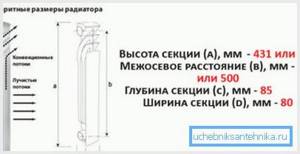
Aluminum products have greater thermal performance than their cast iron counterparts. When asked how many kW is in one part of an aluminum heating device, experts answer that it reaches 0.185-0.2 kW. In the end, for the standard level of heating of a fifteen-meter room, 9-10 sections of metal sections will be enough.
The advantages of such devices:
- not heavy weight;
- beautiful design;
- high level of heat transfer;
- It is possible to control the temperature with your own hands using thermostatic valves.
But aluminum products do not have the same strength as their cast iron counterparts, for example a 2 kW oil heater. Based on this, they are susceptible to surges in operating pressure in the system, hydraulic shocks, and excessively high temperatures of the coolant.
You need to pay attention! At a time when the pH level (acidity) near water is very high, aluminum releases a decent amount of hydrogen. This has a very detrimental effect on our health. Based on this, devices of this kind must be used in a heating system in which the coolant is neutral in acidity.
Durability of cast iron radiators
Cast iron batteries have the highest durability. Their nominal service life is on average 25-35 years. However, many batteries made of high-quality cast iron have been successfully used for more than 50 years. Such a long service life of cast iron heating radiators is achieved mainly due to the high resistance to corrosion due to the thick walls of the batteries and the properties of cast iron.
High reliability and durability of cast iron heating radiators is maintained under specified operating conditions. Cast iron is a fairly brittle alloy. Therefore, heating devices made from it are not designed for high operating pressure (up to 9 atmospheres) . Therefore, in high-rise building systems where significant pressure is applied, cast iron batteries do not demonstrate high durability and reliability. They can also be destroyed by strong water hammer.
Thus, cast iron radiators can last as long as possible, provided they are used in heating systems with relatively low operating pressure and provide effective protection against water hammer.
Lammin Product Benefits
Lammin sells bimetallic and aluminum radiators of the Eco and Premium series of its own production. The warranty period for the first products is 7 years, and for the second - 10. They meet the requirements of European standards and are adapted for use in Russian conditions. High quality heating devices is achieved through the use of modern production lines and the introduction of special developments.
Bimetallic batteries are ideal for heating offices, apartments in multi-storey buildings and industrial premises. They are insensitive to the composition of the coolant, since the design does not allow contact between aluminum and the medium transported through the pipes. Aluminum models are produced using injection molding from a unique alloy and are used for the installation of autonomous heating networks in private homes and country cottages. They are characterized by increased strength and reliability. A protective coating on the inner surface protects the metal from corrosion.
Durability of aluminum radiators
The service life of aluminum radiators is on average 20-25 years. The warranty period for such batteries is usually 5 years. However, such a long service life is ensured only if the standard operating conditions are observed, to which aluminum devices are very sensitive. There are a number of factors that can significantly reduce the durability of this type of heating radiator.
In particular, they are not designed for operation at high operating pressure (although this figure is higher compared to previous types of batteries) and demonstrate poor resistance to water hammer. Corrosion can occur in aluminum radiators due to high acidity, so during their operation it is necessary to control the pH of the coolant.
Corrosion also often occurs if aluminum radiators are left without water between heating seasons. Therefore, it is not recommended to drain water from them.
The characteristics of aluminum radiators allow them to be used only in autonomous heating systems that maintain high quality coolant and stable operating pressure. In such conditions they will be able to show the highest durability and last at least 20 years.
Features of aluminum batteries
Aluminum radiators are also used in heating systems that are not connected to central communications. Operating such batteries in apartment buildings can damage the metal. They are characterized by the following:
- good heat dissipation;
- light weight;
- the ability to select a heating device with the required number of sections;
- variety of shapes and sizes;
- heat distribution by convection flow, which is created due to the shape of the ribs.
Durability of bimetallic radiators
Bimetallic batteries are only slightly inferior in durability to cast iron ones. The service life of radiators of this type is 25-30 years. They are usually guaranteed for a period of at least 10 years. This durability is achieved primarily due to the high strength characteristics provided by the steel core of the bimetallic section.
Bimetallic radiators can easily withstand pressure of at least 20 atmospheres and are characterized by high resistance to water hammer. Some restrictions on the service life of bimetallic radiators are not imposed by the highest corrosion resistance, but this indicator is maintained at a fairly high level.
Bimetallic radiators provide high durability when used in both autonomous and centralized heating systems in high-rise buildings. However, taking into account the efficiency and internal volume indicators, it is more appropriate to use them in centralized systems.

